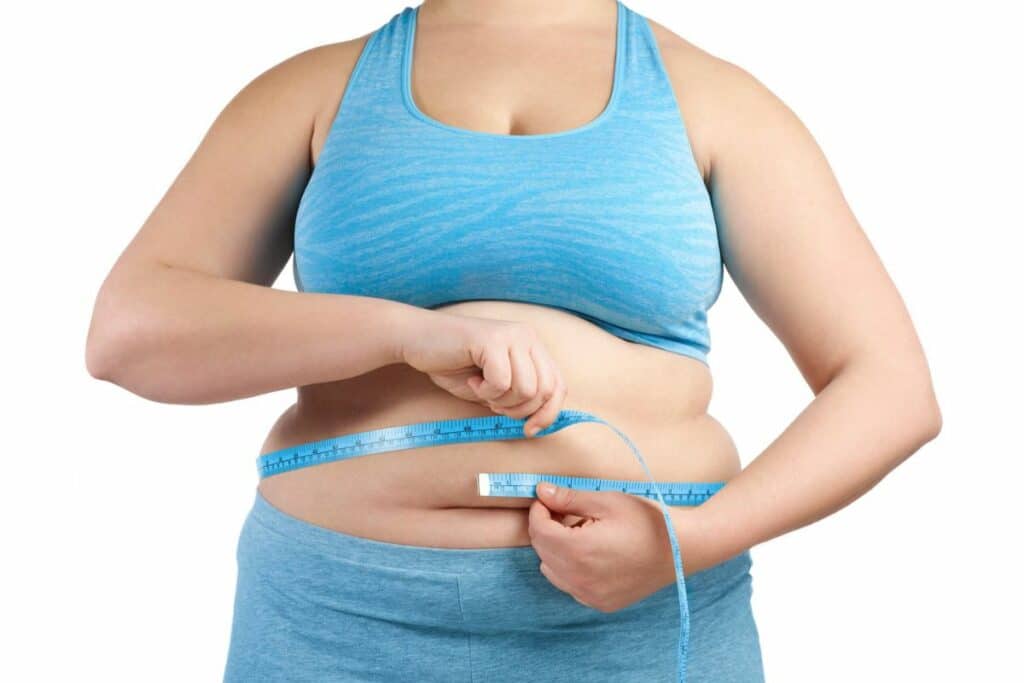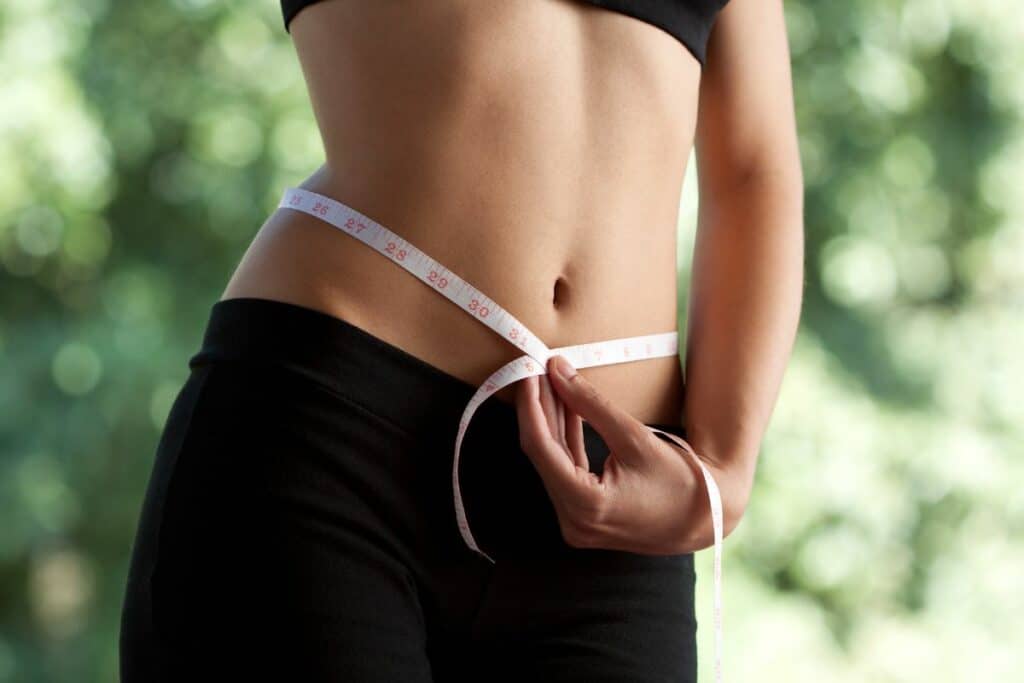Let’s delve deep into the significance of waist circumference and its vital role in assessing overall health.
We all know that too much body fat isn’t a good thing. But did you know that the LOCATION of that fat also matters?
Well it does.
I’m sure you’re all aware of subcutaneous fat, which is the fat located just beneath the skin, in the layer between the skin’s surface and the underlying muscles. It’s the fat that you can pinch with your fingers and is distributed throughout the body, including areas like the thighs,buttocks, hips, and abdomen.
But about one tenth of the fat in your body is what is called visceral fat or intra-abdominal fat.
Visceral fat is stored deep within the abdominal cavity and is not visible from the outside. It surrounds and cushions the vital organs like the liver, pancreas, and intestines.
Although it makes up this small percentage of your total body fat,too visceral fat can be quite dangerous.
Even if you’re very thin with a lot of visceral fat, you can still have a high disease risk.
Why is visceral fat so dangerous?
It was only in the 1990s that researchers concluded that fat cells – especially visceral fat cells- also function as an active endocrine organ.
They release various substances, including inflammatory cytokines and hormones, which can affect metabolic and inflammatory processes in the body.
In fact, excess visceral fat increases the risk of cardiovascular disease, type 2 diabetes, hypertension, and dyslipidemia, collectively contributing to metabolic syndrome.

Risk factors for visceral fat
If you’re wondering, what factors influence the amount of visceral fat that you have, pay attention to this list and try to identify how many risk factors you have.
Firstly, Genetics can play a significant role in where your body stores fat. As such, some people may be genetically predisposed to store more fat in their abdominal area.
Here’s an interesting fact: Some studies show that adults who were born with a low birth weight have more visceral fat.
A diet high in calories, especially from sugars, unhealthy fats, and processed foods, can contribute to the accumulation of visceral fat.
The Lack of physical activity or what is known as a sedentary lifestyle can lead to weight gain with a subsequent increase in visceral fat.
I know a lot of women who complain of gaining weight when they’re stressed. This is likely true. And it’s not only because stress causes you to abandon your healthy lifestyle and turn to comfort eating.
You see, chronic stress also triggers the release of cortisol, a hormone associated with fat storage, particularly in the abdominal area.
Plus cortisol can increase your appetite and make you crave salty, sugary or fatty foods.
Smoking, Insufficient sleep and hormonal changes are also risk factors.
Unfortunately, as women age – especially after menopause, it’s easier for us to store fat in the upper body so our waist sizes can easily increase even when we aren’t gaining weight in any other parts of our bodies.
Alcoholic beverages are often high in calories and can contribute to the accumulation of abdominal fat.
Additionally, medical conditions, such as insulin resistance, metabolic syndrome, and polycystic ovary syndrome or PCOS, can predispose individuals to an increase in visceral fat.
As you may have noticed, although some of these factors like age and genetics are non-modifiable, many are entirely within your control.
Read also: 16 Expert Tips To Be More Active & Quit That Sedentary Lifestyle
How do I calculate my visceral fat?
So,I’m sure you’re wondering, how exactly can you know if you have too much visceral fat?
Well, the best way to know the amount and location of visceral fat is through expensive imaging tests.
However, since most of us do not have access to these, the next best and easiest way is from measuring your waist circumference.
So here’s how you do this.
Measure waist circumference with a tape
It’s quite simple, and all you need is a measuring tape.
It’s best to take the measurement directly over the skin without clothes.
You should measure halfway between your lower rib and top of your hipbone which is generally in line with your belly button.
Don’t try to pull your stomach in. Instead, take the measurement in inches or centimeters when you’re breathing out normally.
Make sure the tape is not compressing the skin.
So, you’ve measured your waistline circumference, but what does it mean?
Read also: 8 Best Tips Based On My Journey With Intermittent Fasting

Understanding visceral fat calculation
Well, the interpretation can vary slightly based on gender and ethnicity, but as a general guideline:
“For men, a waistline measurement above 40 inches (102 cm) and For women, a measurement above 35 inches (88 cm) is typically associated with increased health risks.”
However, it you’re of Asian descent, this number drops to 31.5 inches for women and 35.5 inches for men.
But rather than focusing only on the current reading, pay attention to if your abdominal circumference is increasing overtime.
“So, when should you use waistline circumference, and when should you rely on BMI?
Read also: 4 Proven Steps To Stop Overeating That Work
Visceral fat vs BMI
BMI is more commonly used in clinical practice and public health settings because it is easy to calculate using a person’s weight and height.
BMI measures overall body weight relative to height and doesn’t account for body composition or fat distribution.
Waistline circumference fills this gap by focusing on where fat is stored. You could have a ‘normal’
BMI but still carry excess fat around your waist, which poses health risks.
Conversely, you might have a high BMI due to muscle mass and not excessive fat around your waist, which is less concerning.
Ideally, both measurements should be considered together for a more comprehensive assessment of your health.
Read also: 20 Things to Stop Doing to Stay Healthy in 2024 – AND BEYOND
Final words on How to Measure Waist Circumference & Manage Belly Fat
Luckily, visceral fat is easier to lose than subcutaneous fat.
So once you commit to a healthier lifestyle, your body will start reaping the benefits even before you experience any substantial weight loss.
Remember, exercise and healthy eating is way more than weight loss.
If you’re worried about gaining weight this holiday season, read this next: 16 Surprising Tips To Avoid Holiday Weight Gain
References
Chau YY, Bandiera R, Serrels A, Martínez-Estrada OM, Qing W, Lee M, Slight J, Thornburn A, Berry R, McHaffie S, Stimson RH, Walker BR, Chapuli RM, Schedl A, Hastie N. Visceral and subcutaneous fat have different origins and evidence supports a mesothelial source. Nat Cell Biol. 2014 Apr;16(4):367-75.
Mittal B. Subcutaneous adipose tissue & visceral adipose tissue. Indian J Med Res. 2019 May;149(5):571-573.










